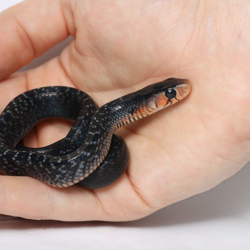Omaha’s Henry Doorly Zoo and Aquarium made history of its own with the Zoo’s first-time birth of four endangered eastern indigo snakes on Wednesday, July 14, and Thursday, July 15.
The offspring, whose eggs were laid on Wednesday, April 14, with the first one pipping on Tuesday, July 13, emerged just in time for World Snake Day, which is today. Once they are able to successfully feed on their own, they will be moved to a habitat visible to the public in the Desert Dome’s Sunroom. Guests are able to see the sire of the offspring in the swamp area of Mahoney’s Kingdoms of the Night.
These births are the result of an Eastern Indigo Species Survival Plan recommendation. An SSP manages the population of a specific threatened or endangered species to ensure it is healthy, genetically diverse and demographically varied across institutions accredited by the Association of Zoos and Aquariums (AZA).
The Zoo has been a member of the program since 2002, the same year the Zoo acquired its first eastern indigo. To increase their breeding success with the species, the Zoo upgraded the eastern indigo’s habitat in 2010, providing a larger, more complex environment for the reptile with more heating structures to trigger natural breeding behaviors.
Eastern indigos are native to the southeastern United States, primarily Florida and southeastern Georgia. They are named for their glossy bluish-black scales and are considered the largest non-venomous snake in the country, reaching up to eight and a half feet in length.
An oviparous, or egg-laying species, adult females will breed from October through February and lay a single clutch of four to 12 eggs from April to July. They rely on gopher tortoise burrows as nesting sites and to seek shelter.
The eastern indigo is a federally threatened species and is protected under the U.S. Fish and Wildlife Service and Florida Fish and Wildlife Conservation Commission. The destruction, fragmentation and degradation of their habitat, the longleaf pine ecosystem, has led to a reduction in gopher tortoise burrows and therefore, their disappearance in southern Alabama and southeast Mississippi. The presence of this species a sign of a healthy ecosystem, as the eastern indigo is the top predator of its food chain.
There are 241 eastern indigos across 31 Association of Zoos and Aquariums-accredited institutions.

